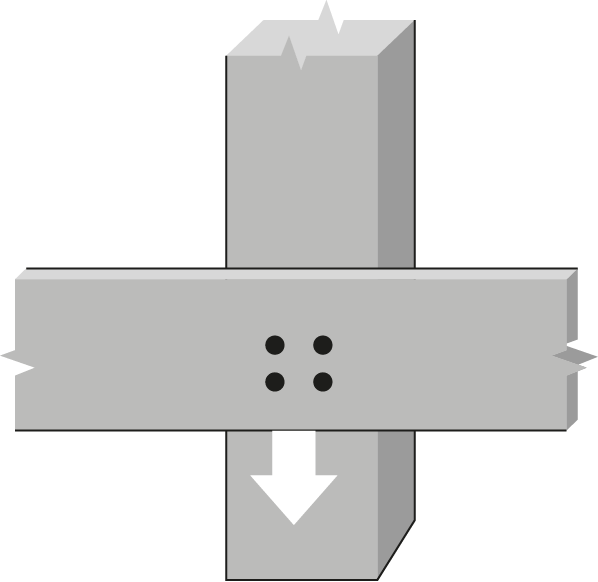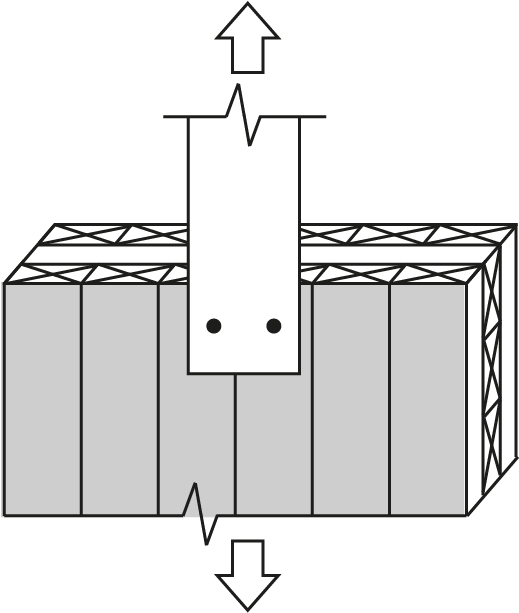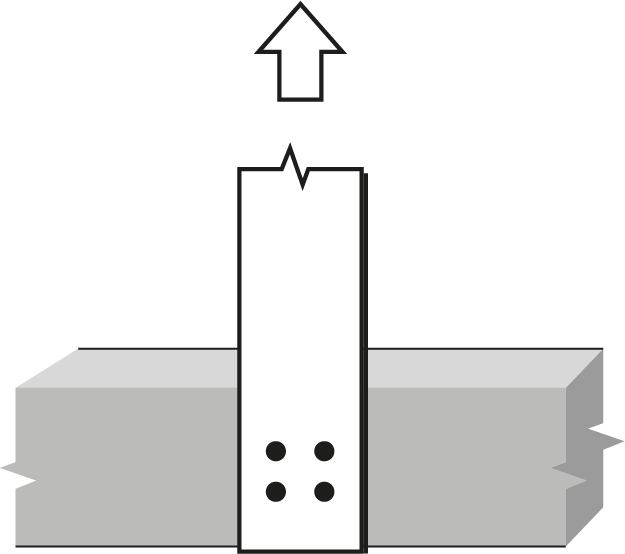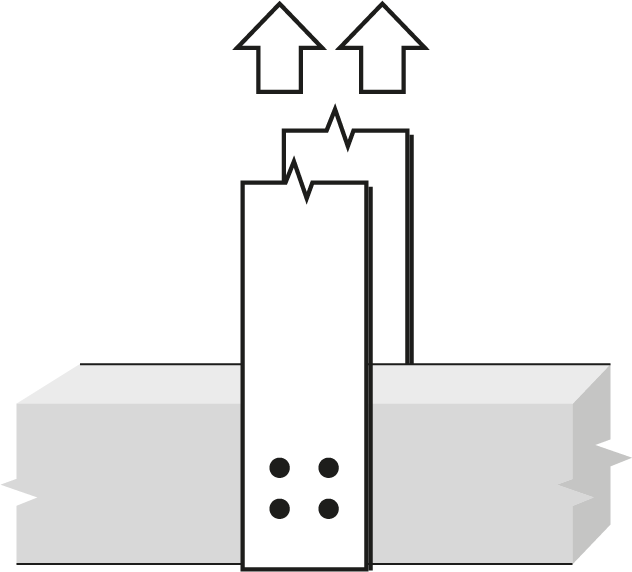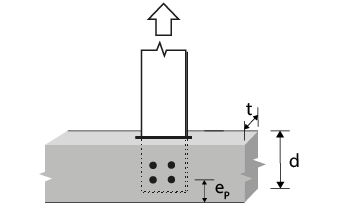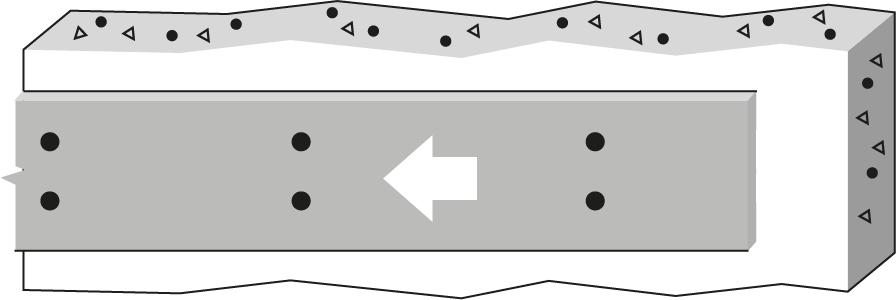 |
5/8″ Bolt or dowel Double Shear, Spruce-Pine glulam to 6 mm steel plates |
 |
|||||||||||||
| Wood Member | Fastener |
 |
|||||||||||||
|
Thickness (mm) |
Depth (mm) |
No. of rows |
 |
No. of fasteners in a row | |||||||||||
| 2 | 3 | ||||||||||||||
| Bolt spacing in a row taken as the minimum of the loaded end distance3, aL, and the spacing between bolts in a row, SR (mm) | |||||||||||||||
| 64 | 95 | 127 | 159 | 190 | 64 | 95 | 127 | 159 | 190 | ||||||
| 80 | 114 | 1 | 0 | 14.9(R) | 22.4(R) | 29.9(R) | 37.3(R) | 37.6(c) | 22.4(R) | 33.6(R) | 44.8(R) | 56.0(R) | 56.4(c) | ||
| 80 | 152 | 2 | 47.625 | 29.9(R) | 44.8(R) | 58.2(G) | 65.7(G) | 73.1(G) | 44.8(R) | 61.9(G) | 73.1(G) | 84.3(G) | 95.5(G) | ||
| 80 | 190 | 2 | 79.375 | 29.9(R) | 44.8(R) | 59.7(R) | 74.7(R) | 75.2(c) | 44.8(R) | 67.2(R) | 89.6(R) | 112(R) | 113(c) | ||
| 80 | 228 | 2 | 111.125 | 29.9(R) | 44.8(R) | 59.7(R) | 74.7(R) | 75.2(c) | 44.8(R) | 67.2(R) | 89.6(R) | 112(R) | 113(c) | ||
| 80 | 228 | 3 | 47.625 | 44.8(R) | 67.2(R) | 86.5(G) | 94.0(G) | 101(G) | 67.2(R) | 90.2(G) | 101(G) | 113(G) | 124(G) | ||
| 80 | 228 | 3 | 62.5 | 44.8(R) | 67.2(R) | 89.6(R) | 112(R) | 113(c) | 67.2(R) | 101(R) | 130(G) | 141(G) | 152(G) | ||
| 130 | 152 | 1 | 0 | 24.3(R) | 36.4(R) | 48.5(R) | 49.5(g) | 49.5(g) | 36.4(R) | 54.6(R) | 72.8(R) | 74.2(g) | 74.2(g) | ||
| 130 | 152 | 2 | 47.625 | 48.5(R) | 72.8(R) | 94.6(G) | 99.0(g) | 99.0(g) | 72.8(R) | 101(G) | 119(G) | 137(G) | 148(g) | ||
| 130 | 190 | 2 | 79.375 | 48.5(R) | 72.8(R) | 97.1(R) | 99.0(g) | 99.0(g) | 72.8(R) | 109(R) | 146(R) | 148(g) | 148(g) | ||
| 130 | 228 | 2 | 111.125 | 48.5(R) | 72.8(R) | 97.1(R) | 99.0(g) | 99.0(g) | 72.8(R) | 109(R) | 146(R) | 148(g) | 148(g) | ||
| 130 | 228 | 3 | 47.625 | 72.8(R) | 109(R) | 141(G) | 148(g) | 148(g) | 109(R) | 147(G) | 165(G) | 183(G) | 201(G) | ||
| 130 | 228 | 3 | 62.5 | 72.8(R) | 109(R) | 146(R) | 148(g) | 148(g) | 109(R) | 164(R) | 211(G) | 223(g) | 223(g) | ||
| 175 | 190 | 1 | 0 | 32.7(R) | 49.0(R) | 49.5(g) | 49.5(g) | 49.5(g) | 49.0(R) | 73.5(R) | 74.2(g) | 74.2(g) | 74.2(g) | ||
| 175 | 190 | 2 | 47.625 | 65.3(R) | 98.0(R) | 99.0(g) | 99.0(g) | 99.0(g) | 98.0(R) | 135(G) | 148(g) | 148(g) | 148(g) | ||
| 175 | 190 | 2 | 79.375 | 65.3(R) | 98.0(R) | 99.0(g) | 99.0(g) | 99.0(g) | 98.0(R) | 147(R) | 148(g) | 148(g) | 148(g) | ||
| 175 | 228 | 2 | 111.125 | 65.3(R) | 98.0(R) | 99.0(g) | 99.0(g) | 99.0(g) | 98.0(R) | 147(R) | 148(g) | 148(g) | 148(g) | ||
| 175 | 228 | 3 | 47.625 | 98.0(R) | 147(R) | 148(g) | 148(g) | 148(g) | 147(R) | 197(G) | 222(G) | 223(g) | 223(g) | ||
| 175 | 228 | 3 | 62.5 | 98.0(R) | 147(R) | 148(g) | 148(g) | 148(g) | 147(R) | 221(R) | 223(g) | 223(g) | 223(g) | ||
| 215 | 266 | 1 | 0 | 40.1(R) | 49.5(g) | 49.5(g) | 49.5(g) | 49.5(g) | 60.2(R) | 74.2(g) | 74.2(g) | 74.2(g) | 74.2(g) | ||
| 215 | 266 | 2 | 47.625 | 80.3(R) | 99.0(g) | 99.0(g) | 99.0(g) | 99.0(g) | 120(R) | 148(g) | 148(g) | 148(g) | 148(g) | ||
| 215 | 266 | 2 | 79.375 | 80.3(R) | 99.0(g) | 99.0(g) | 99.0(g) | 99.0(g) | 120(R) | 148(g) | 148(g) | 148(g) | 148(g) | ||
| 215 | 266 | 2 | 111.125 | 80.3(R) | 99.0(g) | 99.0(g) | 99.0(g) | 99.0(g) | 120(R) | 148(g) | 148(g) | 148(g) | 148(g) | ||
| 215 | 266 | 3 | 47.625 | 120(R) | 148(g) | 148(g) | 148(g) | 148(g) | 181(R) | 223(g) | 223(g) | 223(g) | 223(g) | ||
| 215 | 266 | 3 | 62.5 | 120(R) | 148(g) | 148(g) | 148(g) | 148(g) | 181(R) | 223(g) | 223(g) | 223(g) | 223(g) | ||
| 265 | 342 | 1 | 0 | 49.5(R) | 49.5(g) | 49.5(g) | 49.5(g) | 49.5(g) | 74.2(R) | 74.2(g) | 74.2(g) | 74.2(g) | 74.2(g) | ||
| 265 | 342 | 2 | 47.625 | 98.9(R) | 99.0(g) | 99.0(g) | 99.0(g) | 99.0(g) | 148(R) | 148(g) | 148(g) | 148(g) | 148(g) | ||
| 265 | 342 | 2 | 79.375 | 98.9(R) | 99.0(g) | 99.0(g) | 99.0(g) | 99.0(g) | 148(R) | 148(g) | 148(g) | 148(g) | 148(g) | ||
| 265 | 342 | 2 | 111.125 | 98.9(R) | 99.0(g) | 99.0(g) | 99.0(g) | 99.0(g) | 148(R) | 148(g) | 148(g) | 148(g) | 148(g) | ||
| 265 | 342 | 3 | 47.625 | 148(R) | 148(g) | 148(g) | 148(g) | 148(g) | 223(R) | 223(g) | 223(g) | 223(g) | 223(g) | ||
| 265 | 342 | 3 | 62.5 | 148(R) | 148(g) | 148(g) | 148(g) | 148(g) | 223(R) | 223(g) | 223(g) | 223(g) | 223(g) | ||
| 315 | 380 | 1 | 0 | 49.5(g) | 49.5(g) | 49.5(g) | 49.5(g) | 49.5(g) | 74.2(g) | 74.2(g) | 74.2(g) | 74.2(g) | 74.2(g) | ||
| 315 | 380 | 2 | 47.625 | 99.0(g) | 99.0(g) | 99.0(g) | 99.0(g) | 99.0(g) | 148(g) | 148(g) | 148(g) | 148(g) | 148(g) | ||
| 315 | 380 | 2 | 79.375 | 99.0(g) | 99.0(g) | 99.0(g) | 99.0(g) | 99.0(g) | 148(g) | 148(g) | 148(g) | 148(g) | 148(g) | ||
| 315 | 380 | 2 | 111.125 | 99.0(g) | 99.0(g) | 99.0(g) | 99.0(g) | 99.0(g) | 148(g) | 148(g) | 148(g) | 148(g) | 148(g) | ||
| 315 | 380 | 3 | 47.625 | 148(g) | 148(g) | 148(g) | 148(g) | 148(g) | 223(g) | 223(g) | 223(g) | 223(g) | 223(g) | ||
| 315 | 380 | 3 | 62.5 | 148(g) | 148(g) | 148(g) | 148(g) | 148(g) | 223(g) | 223(g) | 223(g) | 223(g) | 223(g) | ||
|
Notes:
|
. | ||||||||||||||


